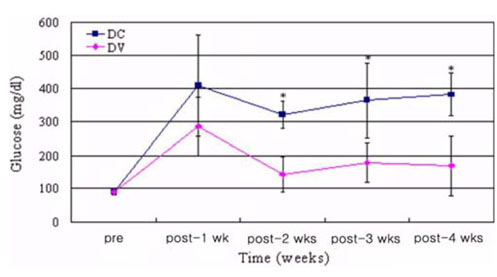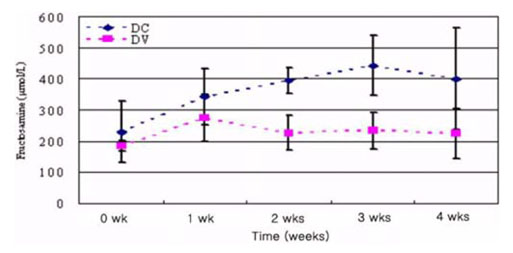J Vet Sci.
2006 Dec;7(4):391-395. 10.4142/jvs.2006.7.4.391.
Hypoglycemic effects of vanadium on alloxan monohydrate induced diabetic dogs
- Affiliations
-
- 1Department of Internal Medicine, College of Veterinary Medicine, Seoul National University, Seoul 151-742, Korea. hyyoun@snu.ac.kr
- KMID: 1089489
- DOI: http://doi.org/10.4142/jvs.2006.7.4.391
Abstract
- The hypoglycemic effects after oral administration of vanadium have been studied previously in many species such as rats, mice and even humans. However, there has been no prior report on the glucose lowering effect of vanadium on diabetic dogs. Therefore, the purpose of this study was to evaluate the hypoglycemic effects of oral vanadium on diabetic dogs. Diabetes mellitus in the dogs studied was induced by alloxan monohydrate intravenous injection. The dogs were divided into two groups, one was the diabetic control (DC) group (n = 4) and the other was the vanadium treated (DV) group (n = 6). Fresh water was supplied to the dogs in the DC group, but sodium metavanadate solution (0.1~0.2 mg/ml) was given to the dogs in DV group from one week after the alloxan injection. The fasting glucose levels, fructosamine and serum chemistry profiles were compared between the two groups weekly for three weeks. The fasting blood glucose levels in DV group were significantly lower than those in the DC group (p < 0.01). Fructosamine levels in the DV group were also lower than those in the DC group (p < 0.05). The serum chemistry profiles were not significantly different in comparisons between the two groups. However, the cholesterol levels were significantly lower in the DV group compared to the DC group (p < 0.05). Our findings showed that oral vanadium administration had a hypoglycemic effect on chemically induced diabetic dogs.
Keyword
MeSH Terms
-
Alanine Transaminase/blood
Alkaline Phosphatase/blood
Animals
Aspartate Aminotransferases/blood
Blood Glucose/metabolism
Blood Urea Nitrogen
Chlorides/blood
Cholesterol/blood
Creatinine/blood
Diabetes Mellitus, Experimental/blood/*drug therapy
Dog Diseases/blood/*drug therapy
Dogs
Female
Fructosamine/blood
Hypoglycemic Agents/*pharmacology
Male
Pancreas/drug effects/pathology
Potassium/blood
Random Allocation
Sodium/blood
Triglycerides/blood
Vanadates/*pharmacology
Figure
Reference
-
1. Anderson HR, Stitt AW, Gardiner TA, Lloyd SJ, Archer DB. Induction of alloxan/streptozotocin diabetes in dogs: a revised experimental technique. Lab Anim. 1993. 27:281–285.
Article2. Black HE, Rosenblum IY, Capen CC. Chemically induced (streptozotocin-alloxan) diabetes mellitus in the dog. Biochemical and ultrastructural studies. Am J Pathol. 1980. 98:295–310.3. Boden G, Chen X, Ruiz J, van Rossum GD, Turco S. Effects of vanadyl sulfate on carbohydrate and lipid metabolism in patients with non-insulin-dependent diabetes mellitus. Metabolism. 1996. 45:1130–1135.
Article4. Brichard SM, Pottier AM, Henquin JC. Long term improvement of glucose homeostasis by vanadate in obese hyperinsulinemic fa/fa rats. Endocrinology. 1989. 125:2510–2516.
Article5. Cam MC, Li WM, McNeill JH. Partial preservation of pancreatic beta-cells by vanadium: evidence for long-term amelioration of diabetes. Metabolism. 1997. 46:769–778.
Article6. Clark RL, Mott DM, Andrews WJ, Foley JE. Insulin-resistant Na+ pump activity in adipocytes from obese humans. Am J Physiol. 1985. 249:E160–E164.7. Dubyak GR, Kleinzeller A. The insulin-mimetic effects of vanadate in isolated rat adipocytes. Dissociation from effects of vanadate as a (Na+-K+)ATPase inhibitor. J Biol Chem. 1980. 255:5306–5312.
Article8. Huang SW, Maclaren NK. Insulin-dependent diabetes: a disease of autoaggression. Science. 1976. 192:64–66.
Article9. Mooney RA, Anderson DL. Phosphorylation of the insulin receptor in permeabilized adipocytes is coupled to a rapid dephosphorylation reaction. J Biol Chem. 1989. 264:6850–6857.
Article10. Shechter Y, Karlish SJ. Insulin-like stimulation of glucose oxidation in rat adipocytes by vanadyl (IV) ions. Nature. 1980. 284:556–558.
Article11. Shechter Y, Ron A. Effect of depletion of phosphate and bicarbonate ions on insulin action in rat adipocytes. J Biol Chem. 1986. 261:14945–14950.
Article12. Tamura S, Brown TA, Whipple JH, Fujita-Yamaguchi Y, Dubler RE, Cheng K, Larner J. A novel mechanism for the insulin-like effect of vanadate on glycogen synthase in rat adipocytes. J Biol Chem. 1984. 259:6650–6658.
Article
- Full Text Links
- Actions
-
Cited
- CITED
-
- Close
- Share
- Similar articles
-
- Edible mushroom (Pleurotus cornucopiae) extract vs. glibenclamide on alloxan induced diabetes: sub-acute in vivo study of Nrf2 expression and renal toxicity
- Studies on the Survival of Skin Homografts in Rabbits Treated with Alloxan
- The Changes of SOD, Catalase and GPX in Alloxan Induced Diabetic Pregnant Rats, Their Feurses and Neonates
- Antihyperglycemic and Antihyperlipidemic Effects of Fermented Rhynchosia nulubilis in Alloxan-induced Diabetic Rats
- Therapeutic Effect of Amomum xanthoides Extract on Experimental Diabetes Induced by Alloxan




